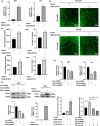Occludin facilitates tumour angiogenesis in bladder cancer by regulating IL8/STAT3 through STAT4
- PMID: 35224833
- PMCID: PMC8995457
- DOI: 10.1111/jcmm.17257
Occludin facilitates tumour angiogenesis in bladder cancer by regulating IL8/STAT3 through STAT4
Abstract
Bladder cancer (BLCA) is a common genitourinary cancer in patients, and tumour angiogenesis is indispensable for its occurrence and development. However, the indepth mechanism of tumour angiogenesis in BLCA remains elusive. According to recent studies, the tight junction protein family member occludin (OCLN) is expressed at high levels in BLCA tissues and correlates with a poor prognosis. Downregulation of OCLN inhibits tumour angiogenesis in BLCA cells and murine xenografts, whereas OCLN overexpression exerts the opposite effect. Mechanistically, the RT-qPCR analysis and Western blotting results showed that OCLN increased interleukin-8 (IL8) and p-signal transducer and activator of transcription 3 (STAT3) levels to promote BLCA angiogenesis. RNA sequencing analysis and dual-luciferase reporter assays indicated that OCLN regulated IL8 transcriptional activity via the transcription factor STAT4. In summary, our results provide new perspectives on OCLN, as this protein participates in the development of BLCA angiogenesis by activating the IL8/STAT3 pathway via STAT4 and may serve as a novel and unique therapeutic target.
Keywords: IL8; OCLN; bladder cancer; tumour angiogenesis.
© 2022 The Authors. Journal of Cellular and Molecular Medicine published by Foundation for Cellular and Molecular Medicine and John Wiley & Sons Ltd.
Conflict of interest statement
All authors agree to submit the article and have no conflict of interest.
Figures





Similar articles
-
BLCA-4 expression is related to MMP-9, VEGF, IL-1α and IL-8 in bladder cancer but not to PEDF, TNF-α or angiogenesis.Pathol Biol (Paris). 2012 Jun;60(3):e36-40. doi: 10.1016/j.patbio.2011.11.009. Epub 2011 Dec 22. Pathol Biol (Paris). 2012. PMID: 22197408
-
M6A-mediated-upregulation of lncRNA BLACAT3 promotes bladder cancer angiogenesis and hematogenous metastasis through YBX3 nuclear shuttling and enhancing NCF2 transcription.Oncogene. 2023 Sep;42(40):2956-2970. doi: 10.1038/s41388-023-02814-3. Epub 2023 Aug 23. Oncogene. 2023. PMID: 37612524 Free PMC article.
-
Metformin targets a YAP1-TEAD4 complex via AMPKα to regulate CCNE1/2 in bladder cancer cells.J Exp Clin Cancer Res. 2019 Aug 27;38(1):376. doi: 10.1186/s13046-019-1346-1. J Exp Clin Cancer Res. 2019. PMID: 31455378 Free PMC article.
-
STAT proteins as novel targets for cancer drug discovery.Expert Opin Ther Targets. 2004 Oct;8(5):409-22. doi: 10.1517/14728222.8.5.409. Expert Opin Ther Targets. 2004. PMID: 15469392 Review.
-
Association of STAT3 and STAT4 polymorphisms with susceptibility to chronic hepatitis B virus infection and risk of hepatocellular carcinoma: a meta-analysis.Biosci Rep. 2019 Jun 20;39(6):BSR20190783. doi: 10.1042/BSR20190783. Print 2019 Jun 28. Biosci Rep. 2019. PMID: 31160486 Free PMC article.
Cited by
-
Identification of NIFTP-Specific mRNA Markers for Reliable Molecular Diagnosis of Thyroid Tumors.Endocr Pathol. 2023 Sep;34(3):311-322. doi: 10.1007/s12022-023-09781-1. Epub 2023 Sep 2. Endocr Pathol. 2023. PMID: 37658903 Free PMC article.
-
Triptolide suppresses IL-1β-induced expression of interleukin-8 by inhibiting ROS-Mediated ERK, AP-1, and NF-κB molecules in human gastric cancer AGS cells.Front Oncol. 2025 Jan 30;14:1498213. doi: 10.3389/fonc.2024.1498213. eCollection 2024. Front Oncol. 2025. PMID: 39950099 Free PMC article.
-
An Overview of Angiogenesis in Bladder Cancer.Curr Oncol Rep. 2023 Jul;25(7):709-728. doi: 10.1007/s11912-023-01421-5. Epub 2023 Apr 13. Curr Oncol Rep. 2023. PMID: 37052868 Free PMC article. Review.
-
Expression of Interleukin-8, Interleukin-12 and Interleukin-13 in Esophageal Squamous Cell Carcinoma: Biomarker Potentiality and Prognostic Significance.J Gastrointest Cancer. 2024 Sep;55(3):1239-1255. doi: 10.1007/s12029-024-01063-1. Epub 2024 Jun 23. J Gastrointest Cancer. 2024. PMID: 38910194
-
WNT7A promotes tumorigenesis of head and neck squamous cell carcinoma via activating FZD7/JAK1/STAT3 signaling.Int J Oral Sci. 2024 Jan 22;16(1):7. doi: 10.1038/s41368-024-00279-y. Int J Oral Sci. 2024. PMID: 38246919 Free PMC article.
References
MeSH terms
Substances
Grants and funding
- 2021qntd35/The Fundamental Research Funds for the Central Universities, Sun Yat-sen University
- JCYJ20190807160209294/Shenzhen Science and Technology Innovation Commission, China
- JCYJ20190807160813467/Shenzhen Science and Technology Innovation Commission, China
- 32100564/National Natural Science Foundation of China
- 32170789/National Natural Science Foundation of China
LinkOut - more resources
Full Text Sources
Medical
Miscellaneous

